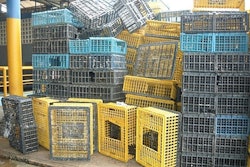
Despite our knowledge of the epidemiology of Mycoplasmas and improvements in diagnostic methods and control strategies, outbreaks continue to occur and cause economic losses for poultry producers in many regions of the world. The prevention and control of Mycoplasma infections in broiler production must consider the following factors:
1. Virulence, concurrent infections, environmental conditions
The severity of infections caused by Mycoplasma gallisepticum (MG) or Mycoplasma synoviae (MS) depends on the virulence of the field strains and can be intensified by several factors (Figure 1).
MG or MS infections combined with live respiratory vaccines and other pathogenic organisms and house environmental conditions can result in chronic respiratory disease (CRD) and severe negative effects on live performance (growth, body weight gains, feed conversion ratio, egg numbers, shell quality and hatchability), leg health, and flock livability.

Figure 1. The severity of MG and MS infections in breeders and broilers depends on the virulence of the Mycoplasma strain and can be intensified by live respiratory vaccines, concurrent infections with other respiratory viruses and opportunistic bacteria, and house environmental conditions. | Courtesy Aviagen
2. Effective biosecurity
MG and MS can be transmitted horizontally and vertically. Other farms, back yard poultry, and wild birds can be a source of infection. The best method to prevent the introduction and spread of Mycoplasmas is the establishment and implementation of an effective biosecurity program which should include the following at a minimum:
a) A biosecurity coordinator;
b) A company written plan;
c) Education and training of all personnel;
d) Requirements for employees and visitors;
e) Definition of buffer and line of separation zones;
f) Procedures and personal protective equipment before entering the farm;
g) Measures to avoid contact with wild birds and other poultry;
h) Cleaning and disinfecting procedures (houses, equipment, and vehicles);
i) Bird mortality disposal;
j) New litter management and disposal procedures;
k) Requirements for flock replacements.
l) Reporting of clinical signs and mortality
m) Auditing.
3. Sourcing, maintaining Mycoplasma-free flocks, monitoring status
Obtaining day-old chicks from MG and MS free suppliers is essential to achieve optimum live performance and bird welfare.
Figure 2 shows a production system designed to reduce or eliminate the use of antibiotics that starts by obtaining Mycoplasma free breeding stock, maintaining flocks free during the rearing and production phases, establishing and implementing biosecurity practices to prevent the introduction, routinely monitoring the status of the flocks, and producing Mycoplasma free day-old chicks to supply broiler farms.
ELISA testing for MG and MS is a popular screening method that can be automated for large scale testing. PCR testing is a rapid and sensitive method to confirm presumptive serological diagnosis or to perform routine screening. DNA sequencing can be conducted on PCR positive samples to differentiate field strains from vaccine strains.

Figure 2. Production system designed to reduce or eliminate the use of antibiotics by obtaining and maintaining MG and MS breeder flocks and supplying free chicks to broiler farms. | Courtesy Aviagen
4. Elimination of infected flocks
Elimination of infected breeder flocks is the best long-term prevention strategy. Today, producers depend on the availability of MG and MS free breeding stock. Suppliers of breeding stock rely on strict biosecurity and monitoring programs designed to prevent the introduction and spread of Mycoplasmas and the detection and elimination of confirmed positive flocks.
Growing demand for broiler meat products produced with reduced or no antibiotics and high welfare standards make it essential for producers to obtain and maintain Mycoplasma-free flocks.
5. Vaccination with live vaccines
Live MG and MS vaccines are used in breeders in some regions where there is an imminent risk of exposure and infection (due to proximity to positive flocks) and where the elimination of infected flocks is not feasible. Vaccination against MG and MS can also help by reducing the need for antibiotics.
Vaccines can confer persistent mucosal immunity, induce a variable serological response, protect against clinical signs, reduce losses due to reduced performance, and prevent transmission. Ensuring optimal protection through vaccines requires flocks to be free of infection before vaccination, and proper vaccine handling and administration. No antibiotics with anti-Mycoplasma activity should be used before or following vaccination.
6. Antibiotic medication
Mycoplasmas are susceptible to tetracyclines, fluoroquinolones, tylosin, tiamulin, tilmicosin, and combinations of lincomycin and spectinomycin. If inline with local legislation medication in feed and/or drinking water is a useful tool to reduce transmission and alleviate clinical signs. However, it is not a long-term solution as it has a significant cost and does not eliminate the risk of infection or possible transmission of field strains to other farms. Administration and dosing of antibiotics must follow the product guidelines and mandatory withdrawal times.
Webinar: How to control Mycoplasma infections in poultry flocks
www.WATTPoultry.com/events/2100















